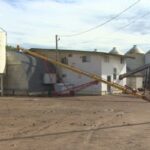British ColumbiaA Nisga’a totem pole from the house of Laay’ is returning to the territory in northwestern B.C. after being housed in the Museum of Anthropology at the University of British Columbia since 1947.Pole officially leaves the Museum of Anthropology in Vancouver on Sept. 18Santana Dreaver · CBC News · Posted: Sep 01, 2025 10:00 AM EDT | Last Updated: 2 hours agoHouse Chief Bruce Haldane is finishing the work of bringing the House Laay’ pole back to Nisga’a territory from Vancouver, a journey that his brother Chief Hubert Haldane, who has since died, started two and a half years ago. (Tony Robinson)Family members of the House of Laay’ are anticipating the return of their totem pole after it was removed from Nisga’a territory in northwestern B.C. almost 80 years ago. “Families used to live along the Nass River, their poles, their stories, their beings would be placed in front of the long houses of the family,” said Rodney Moore, Nisga’a Nation’s forest resource manager.The pole has been housed inside the Museum of Anthropology (MOA) in Vancouver since 1947 when it was bought by anthropologist Marius Barbeau. Susan Rowley, MOA director, says that although the pole was technically purchased, it’s important to consider the ethics of how museums acquire items.WATCH | Century-old Nisg̱a’a totem pole appears to awaken ahead of journey home:Century-old Nisg̱a’a totem pole appears to awaken ahead of journey homeA Totem pole is making its way from Vancouver to Laxgalts’ap in northern B.C., back to where it belongs. As CBC’s Wawmeesh Hamilton reports, delegates from the Nisg̱a’a Nation got together to bless the pole before it started the journey.The pole was purchased during the Canadian government’s ban on the potlatch, and at a time when Indigenous people were experiencing great financial hardships and being taken to Indian Residential Schools, she says. “Even if our records indicate a purchase, we still need to be mindful and think about the ways that it was actually acquired,” she told CBC News. Ahead of the 800- to 900-kilometre journey to the Nass Valley, members of the family had a pole blessing ceremony at the University of British Columbia (UBC).Rodney Moore, left, Chief Bruce Haldane and Anthony Moore attended a blessing ceremony for the Sim’oogit Laay’ Nisga’a totem pole at the UBC Museum of Anthropology ahead of its journey home. (Tony Robinson)A delegation of Nisga’a members use cedar boughs to ‘brush’ the totem pole and bless it. (Tony Robinson)”When anything of value is being moved and is sacred, we would bless and it would help out — not only the pole, but it would also help the family,” Moore said. He attended the blessing ceremony in Vancouver with a delegation of Nisga’a members — where cedar boughs were used to brush down the crate holding the pole for transportation.Cedar is considered a sacred medicine among many Indigenous groups, with “brushing” being common on the West Coast. Brushing is when you use cedar boughs to wipe something or someone down to bless it — or, “brush it.” Sim’oogit Laay’Sim’oogit is the Nisga’a word for chief, and Laay’ is the house that the totem pole belongs to.Rowley says the repatriation work of the pole was led by Sim’oogit Laay’, also known as Chief Hubert Haldane, when he encountered the pole in the museum in September 2023. He was at the museum for a dance performance when another Nisga’a totem pole was returning from Scotland.Haldane has since died, with the next nameholder of Sim’oogit Laay’, also known as Chief Bruce Haldane, finishing the work of returning the pole back to Nisga’a territory. Sim’oogit Ni’isjoohl (Chief Earl Stephens) and Noxs Ts’aawit (Dr. Amy Parent) stand with the Ni’isjoohl memorial pole in the National Museum of Scotland on Aug. 22, 2022. (Neil Hanna/National Museums Scotland)Moore says that within six months of requesting the pole back, MOA had agreed to return it. Rowley says the repatriation process with the museum goes through the UBC board of governors, who confirmed in June 2024 that the pole would be returning to family members of the House of Laay’.The pole is making its way to its final resting place in the Nisga’a museum in Laxgalts’ap, a village northwest of Terrace, B.C., on Sept. 18.”[It’s] wonderful that the pole is [reuniting] with the family, and will continue to do the important work that it was carved to do,” said Rowley. Moore, who saw the pole for the first time during the pole’s blessing ceremony, says he was in awe seeing the carving work from a century ago.”The house of Laay’, this [totem pole] is their belonging, their history, their story, their family member,” he said. ABOUT THE AUTHORSantana Dreaver is a Saulteaux and Plains Cree journalist based in Vancouver. She was raised in northern Saskatchewan and is a member of Mistawasis Nehiyawak. She has a background in political science and reports on Indigenous affairs, culture and governance. With files from Wawmeesh Hamilton
Monday, 22 Dec 2025
Canada – The Illusion
Search
Have an existing account?
Sign In
© 2022 Foxiz News Network. Ruby Design Company. All Rights Reserved.
You May also Like
- More News:
- history
- Standing Bear Network
- John Gonzalez
- ᐊᔭᐦᑊ ayahp — It happened
- Creation
- Beneath the Water
- Olympic gold medal
- Jim Thorpe
- type O blood
- the bringer of life
- Raven
- Wás’agi
- NoiseCat
- 'Sugarcane'
- The rivers still sing
- ᑲᓂᐸᐏᐟ ᒪᐢᑿ
- ᐅᑳᐤ okâw — We remember
- ᐊᓂᓈᐯᐃᐧᐣ aninâpêwin — Truth
- This is what it means to be human.
- Nokoma











